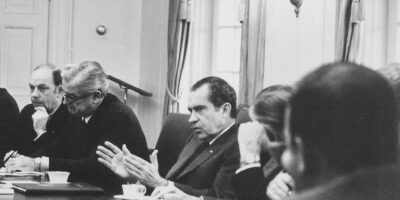No Complex Society Can Be Socialist
Authoritarian movements, both from the left and the right, are on the rise again around the world. In an age where the process of creative destruction takes place faster than ever before, people look for help, for someone to finally make sense of the supposed chaos and bring order back into life. Thus, many have moved to strong leaders in a search for stability, particularly in the West.
As Donald Trump noted in his State of the Union address, some people are even calling for socialism, despite a long history of terrible failure and evil. “Tonight,” he said, “we renew our resolve that America will never be a socialist country.” Indeed no complex society can be.
One of the 20th century’s great thinkers, Friedrich A. von Hayek, always despised such top-down systems of economic planning. Works like his most popular The Road to Serfdom are a strong rebuke to such authoritarian systems, and his concept of the spontaneous order, perhaps the most significant of his many groundbreaking ideas, provides an alternative vision of an order that does not exist when a strongman is in place.
One of his lesser-known essays, “Kinds of Order in Society,” which was published in 1981, sheds further light on Hayek’s conception of different orders, and explains how the search for security through a big government will always stay fruitless.
In Hayek’s opinion, an order of some sort is obviously needed in society: “A complete absence of an order cannot be seriously maintained.” To have no order whatsoever would lead to chaos. But which kind of order is most suitable to coordinate millions of activities a day “is the central problem of social theory and social policy.”
Order, Two Kinds
There are two kinds of order. One is that of the spontaneous, or polycentric, order, “which, though it is the result of human action, has not been created by men deliberately arranging the elements in a preconceived pattern.” In the other, the organization, “relations between the parts” are instead arranged “according to a preconceived plan” by some central planner.
While most people think that ordered activities are the result of such a planner, much of the order “of which we speak is, however, not of this kind.” Indeed, much of what we take for granted is not ordered deliberately, such as the world of physics or biology. Still, even in social phenomena the spontaneous order is clearly active, as in language, where the fact that social phenomena “possess an order which nobody has deliberately designed and which we have to discover, is now generally recognized.”
In the field of the social sciences, however — regardless of whether in politics, economics, or culture — the concept of organization, of a mastermind directing life, still often dominates in hearts and minds. It is in human affairs, nonetheless, where we find the most impressive examples of spontaneous order, such as the market.
In Hayek’s words, the division of labor on which our economic system rests is the best example of such a daily renewed order. In the order created by the market, the participants are constantly induced to respond to events of which they do not directly know.” Indeed, the market system is “an order which consists of the adaptation of the multitudinous circumstances which no single person can know completely.”
In today’s global market, coordinating mechanisms like the price system have evolved spontaneously, and while no one is in charge, the trillions upon trillions of transactions and interactions still take place almost flawlessly. It is tempting to think that someone is in charge of it, if only an invisible hand. But spontaneous orders do not only come into being in the market, but in social life in general. Indeed, many social rules, mores, habits, and traditions evolve in such a bottom-up process.
This does not mean that no type of deliberately created order is necessary at all. While the rule of law, the general and absolutely necessary rules of a society, may come into being spontaneously as well, it needs to be enforced in some way. That rule of law should not direct every minute detail in society, but rather simply create the framework in which the spontaneous order can exist and unfold and which leaves “the individual to create his own position.” For Hayek, this organization seems to be the state, though he does, in this essay, leave the door open for any organization that could enforce the rule of law (so, if it has that ability, perhaps also some other social institution may serve that function).
What would be a big mistake, however, is if we put too much trust in this organization and look to this institution to actively impede the spontaneous ordering process. In primitive, tribal societies it may be “conceivable that all activities are governed by a single mind.” But in societies that go beyond that, the organizational approach will quickly hit its boundaries, if only for the reason that no single mind could know and control all activities in that society.
“There is no such thing as a fully planned society of any degree of complexity.” Modern society is so complex and global today for the simple reason that “it was not dependent on organization but grew as a spontaneous order.”
Down with Ordnungsgestaltung
Those that demand a government that actively plans human affairs because social life has become too complex today to still be left alone commit a fatal error. Hayek writes, “The fact is rather that we can preserve an order of such complexity only if we control it not by the method of ‘planning,’ i.e., by direct orders, but on the contrary aim at the formation of a spontaneous order based on general rules.”
Doing otherwise, by demanding the German approach of Ordnungsgestaltung (i.e. order creation), would merely lead to catastrophe in the long run. This conception of law “is the conception prevailing in totalitarian states,” and while those demanding order creation might not advocate totalitarianism themselves, they possibly will still get it sooner or later.
Thus, Hayek’s conception of the spontaneous order, merely complemented to a small extent by an organization to provide a general framework, is an argument against authoritarianism of any sort, especially today, as society has grown even more complex and thus more complicated, making central planning even more utopian. But not only this: the spontaneous order is also an important argument in favor of freedom.
As Hayek himself writes, “In the social field it provided the foundation for a systematic argument for individual liberty.”











